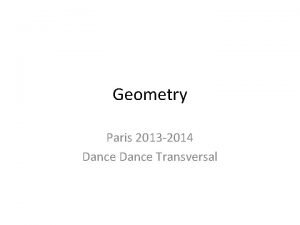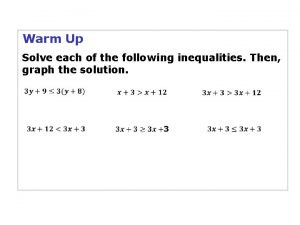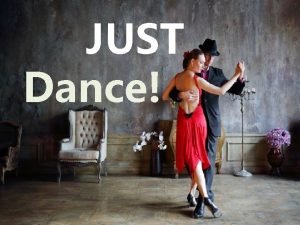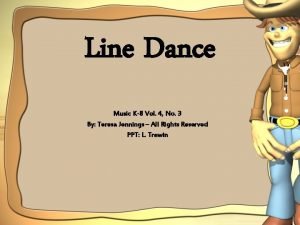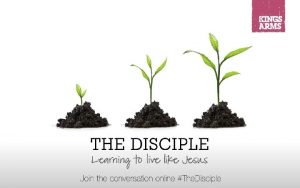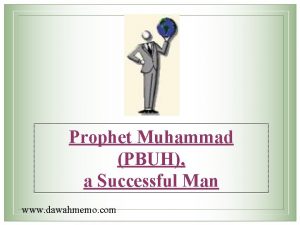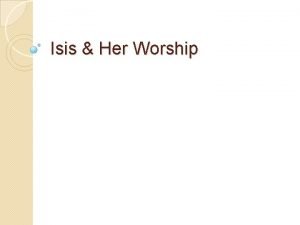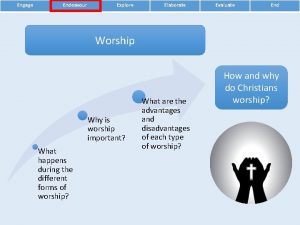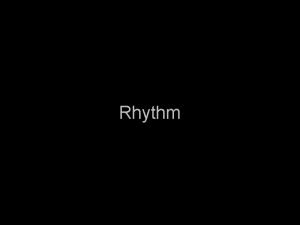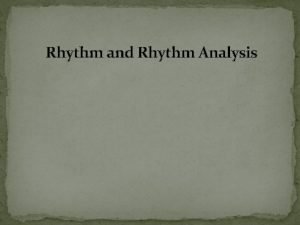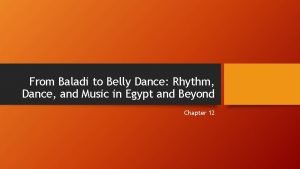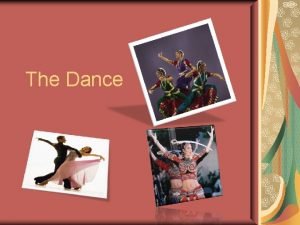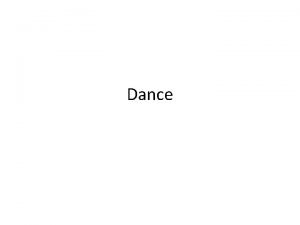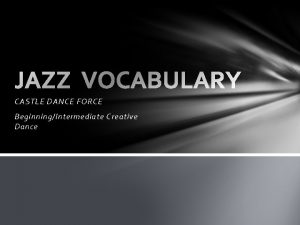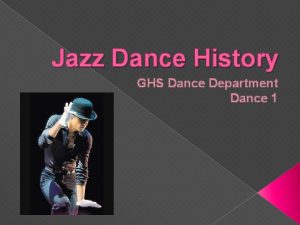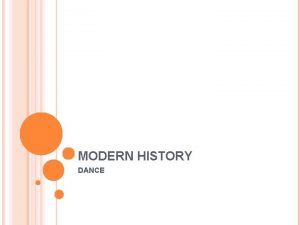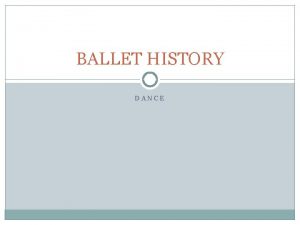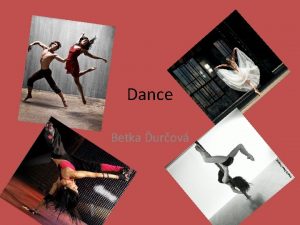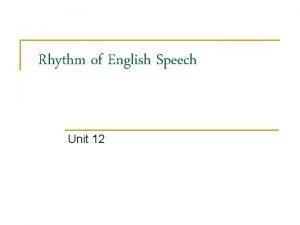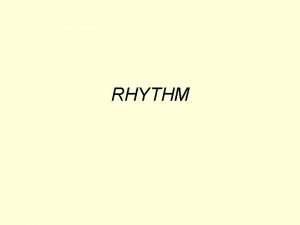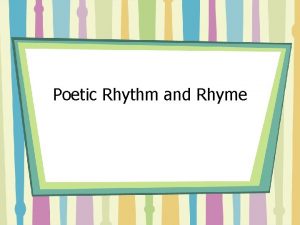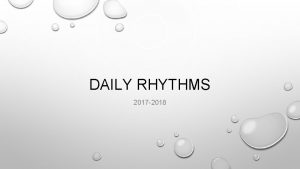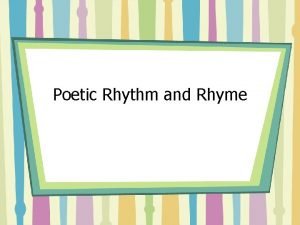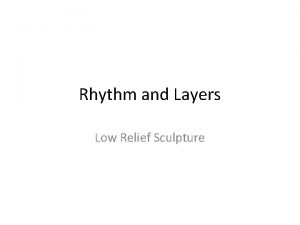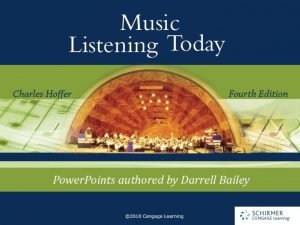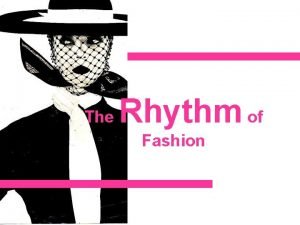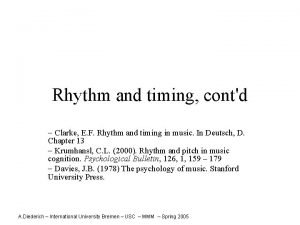The Rhythm of Worship Worship Dance as it



















































- Slides: 51

The Rhythm of Worship

Worship & Dance as it relates to Yah’s perfect sense of order • Levitical / Davidic Dancing • Dance in Ancient Israel • Yah’s Perfect Order • • Dances in Scripture Dance Definitions Postures of Praise Worship & Dance Today

Levitical / Davidic Dancing What is meant by Levitical dancing or Davidic dancing? Levitical is a reference to the Levitical Priests who ministered to Yah with song and dance. The priests were divided up into 12 divisions with one division devoted to worshipping Yah. First Chronicles 25 is an entire chapter devoted to priests who …

“… were the sons of Heman the sovereign’s seer in the words of Elohim, to exalt his horn. For Elohim gave Heman fourteen sons and three daughters. All these were at the hands of their father for song in the House of YHVH’ with cymbals, harps, lyres, for the service of the House of Elohim. And the number of them, with their brothers who were taught in the songs of YHVH, all who were skilled, was two hundred and eighty-eight. ” I Chron. 25: 6 -8

Second Chronicles 1 says, “…who should prophesy with lyres, with harps, and with cymbals, ” referring to the Levitical priests who performed music, worship and dance.

• Davidic is a reference to dancing as King David did with all his might, unencumbered. Second Samuel 6: 14 says, “Then David danced before the Lord with all his might; and David was wearing a linen ephod. ” The priests always wore a linen ephod when entering into the Holy of Holies to minister to YHVH.

• Other terms that are used to describe dance are Messianic Dance, Prophetic Dance, Liturgical Dance, Sacred Dance, Worship Dance, Praise Dance and Celebration Dance. Regardless of the title or name, it’s all the same. • The dancing terms are international and cross cultures because they celebrate the Kingdom of Yah. If you visit any congregation that does Davidic, Levitical or Messianic dance, you will recognize many of these steps and you would be able to join in most dances.

Dance in Ancient Israel • From the beginning, Jewish dance has been a part of the religious experience. Even today dance is a part of every child’s education. To the Jews, dance was always a prayer accompanied by music, singing or beating of the drums. There are many references to the dance in the Torah. The first mention of dance in the Torah is in Exodus 15: 20 “And Miriam the prophetess, the sister of Aaron, took the timbrel in her hand. And all the women went out after her with timbrels and with dancing. ”

• The Hebrew dances were very athletic in structure. They were done by a chorus. The military used dance as a means of training. They danced as David did with finesse and freedom. They danced to a choir and musicians. The dance was highly respected in Israel. At this time, dance was not only connected with everyday activities; Prophets, priests and kings danced, as well as armies, maidens and lads, the young and old alike were dancing. Everyone danced.

• In the Apostles writings believers turned to the Psalms and Prophets in their praise, preaching and teaching. Dancers danced to Psalms sung by the choir and accompanied by the musicians. Temple worship reaches it peak during Feast days around 40 AD/CE. We have records of half a million devout Jews flowing into Jerusalem three times a year to worship Yahweh during His appointed Feast days. It was at one of these times, during Shavuot or Pentecost that the early assembly or the Kahal was born.

Yah’s Perfect Order • In Scripture we see a relationship between spoken sound and transference of energy to receptacles. In Genesis Chapter 1 Yeshua (the Word of Elohim according to John 1: 1) spoke into existence the molecules of the Heaven and the Earth. The molecules were formless, void and empty (without motion). The Spirit of Elohim moved or hovered (creating motion) over the face of the waters, putting the molecules into motion or rhythm.

• Everything Yah created in the heavens and on the earth has form, order, motion, rhythm and vibration. The sun, moon, earth, the stars and the constellations all have order and rhythm. The rain, snow, wind, ocean tides, waterfalls, fire, earthquakes, tornados and hurricanes also have rhythm. Even time has order and rhythm.

• Isaiah 55: 11 So shall My word be, which goes out of My mouth; it shall not return to Me void (motionless without transference of vibration or energy, not brought into order), but it shall accomplish what I please, and it shall certainly do what I sent it to do. • Jeremiah 4: 23 I looked on the earth, and, lo, it was without form and void (motionless without transference of vibration or energy, not brought into order); and the heavens, and they had no light.

• Man lives and moves with order and rhythm; from his heartbeat, to walking, dancing and playing music. Even giving birth has rhythm. Yah breathed into man the breath of life in perfect rhythm and order. • Man response with exhaling His Name “YAHWEH” in perfect order and rhythm. To be one with Yah and to be “in sync” with Yah is to breathe, live and move in His perfect order. • Man is the perfect receptacle to reverberate vibration back to Yah in the Heavens for it shall not return void.

• Mankind was created to receive Yah’s Word, to proclaim it through out the world and to reverberate it back to the heavens, to be receptacles and conduits of His power (energy or vibration), to bring His word to full effectiveness and to produce good works, thus reflecting His glory and majesty. To be imitators of His perfect order.

• Music and dance are viable conduits to do that. Music is one way which man can worship Yah with perfect order. When musicians play the same piece of music in the same key, at the same tempo and rhythm as one body reverberating sound from one set of vocal cords in perfect harmony.

• The same is true with dancers. They move in unison as one entity, a corporate body, with hearts beating in perfect rhythm with each other. Creating a rhythm that reverberates through the heavens back to Yah.

• Worship is at the heart of YHVH. He says He inhabits the praises (vibrations) of His people. He says our prayers (vibrations) ascend into the heavens upon the smoke of the incense (remember fire creates both energy and vibrations).

• Yah is eternal and He is not limited to time or bound to the laws of time, therefore He inhabits the praises of the righteous continually - Adams, Noah's, Abrahams, Isaacs and Jacobs, the Judges, the Prophets, the Kings and ours. Our praises enter into His presence in the throne room with the praises of the Patriarchs.

Dances in Scripture There were many different types of dances done in Ancient Israel referenced in scripture. • The Dance of Anointing: Accompanied with the flute to bring the presence of the Lord: 1 Samuel 10: -5 -10, 1 Kings 1: 40.

• The Dance of the Ascent Procession or “Entrance”: Was a call to worship, done on the way up to the Temple Mount. David danced to bring up the ark: 1 Chronicles 15: 29, 2 Samuel 6: 21, Psalm 120 -134, and the Psalms of Ascents. David and the people of Israel danced before the Ark of the Lord which represented the presence of God: 2 Samuel 6: 14, Psalms 48: 12, 42: 4, and 26: 2.

• The Dance of Dedication: Done at the dedication of the temple: Jeremiah 31: 4, 13 and Psalm 30: 11 and Nehemiah 12: 27. • The Dance of Deliverance: As the song of deliverance came forth, the feet were put to use along with clapping: Psalm 32: 7. • The Dance of Fasting: 2 Chronicles 25: 25. • The Dance of Feasting: Accompanied by harps and tambourines: Psalm 118.

• The Dance of Greeting: Usually done by women to greet the Sabbath: Judges 11: 34. • The Dance of the Mourning Procession: A dance lead by one flutist and two lamenting: Jeremiah 9: 20, Luke 7: 32. • The Dance of Praise and Worship: A round dance with chorus. Sometimes done as a solo: Psalms 149: 3, 150: 4, 1 Chronicles 16: 20, Psalms 96: 6 and 30: 11.

• The Dance of Victory: Was danced with many palm branches waved by the people: Exodus 15: 20, 1 Samuel 18: 6 and 1 Chronicles 15: 29. At the defeat of Pharaoh's armies following the crossing of the Red Sea were “Miriam, the prophetess, the sister of Aaron, took a timbrel in her hand; and all the women went out after her with timbrels and with dancing”: Exodus 15: 20. Also when David slew Goliath, the women sang 'to one another in dance': 1 Samuel 29: 5.

• Dance of the Wedding Processional: Was danced to the groom’s house by the bride and her maidens, also done around the bride and groom in the ceremony: Song of Solomon 3: 11, Isaiah 61: 10, Genesis 29: 33 and 24: 61, and Psalm 30: 11.

Dance Definitions There are 15 different Hebrew words 6 Greek words that describe dance. The word ‘dance’ is not used often in our English Bibles, but the activity of dance is. It appears hundreds of times in Scripture, in terms such as: rejoice, make merry, praise, joy, glad, celebrate and bless.

• Other words that refer to dance are twirl, twist, spin, turn, leap, jump, hop, skip, run, stomp, spring, to bound, to be light and agile, march, walk, to reel to and fro, to revolve, surround, border, procession, as strolling along, travel, caravan or company, using the hands, to revere or worship with extended hand with graceful gestures, to show or point out with the extension of the hands. A sacrifice of praise, thanksgiving and celebration, to “Selah” (stop, pause, ponder & act out).

1) Chag - this is the word we get the word ‘feast’ from which means ‘to whirl about with giddiness’. In the Torah, the Feasts were celebrated with dance to YHVH. 2) Rikud – to skip or leap for joy. 3) Hul – refers to the whirl of the dance and implies a highly active movement.

4) Halal – (#1984) to praise, to celebrate hilariously, to be boldly carefree, to rave, to boast, to make a show, to show forth. The root word in ‘Hallelu. Yah’ means to ‘Praise Yah’. Ps 148: 1; 150: 1 -6 “Who ever offers praise, glorifies Me” Ps 50: 23 “Great is YHVH, and greatly to be praised. ” 1 Chr. 16: 24

5) GUWL - (#1523) to spin around under the influence of strong emotion; to spin like a top; to rejoice and be glad. Most often translated "rejoice. ” "Let the daughters of Judah exult" Ps 48: 11 "Let us rejoice and be glad in His salvation” Isa 25: 9 "Let the heaven rejoice, and let the earth be glad” Ps 96: 11 "Be glad and rejoice forever in what I create; for behold, I create Jerusalem for rejoicing and her people for gladness” Isa 65: 18 -19 "YHVH your Elohim in your midst, . . . He rejoices over you with joy…He rejoices over you with singing” Zeph 3: 17

6) ALAZ - (#5937) to rejoice, to exult, to jump for joy. Most often translated "exult" or "rejoice” "Let the kind ones exult in glory” Ps 149: 5 "Let the field exult and all that is in it” Ps 96: 11 7) PAZAZ - (#6339) to leap, to spring, as if separating the limbs. "King David, leaping and dancing before YHVH” II Sam 6: 16 8) RAQAD - (#7540) to leap, to stamp, to spring about wildly with joy. "King David leaping and making merry” I Chr. 15: 29

9) MACHOWL- (#4234) a round dance "Praise His Name in a dance” Ps 149: 3 "Praise Him with timbrel and dance” Ps 150: 4 "The virgin shall rejoice in a dance” Jer 31: 13 "All the women went out after her with timbrels and dancing” Ex 15: 20 "The women came out …singing and dancing to meet Saul” I Sam. 18: 6 "You have turned my mourning into dancing” Ps 30: 11

10) MACHOWLAH - (#4246) a dance, company dances. "Then Miriam the prophetess, the sister of Aaron, took the tambourine in her hand, and all the women went out after her, with timbrels and dancing" Ex 15: 20 "Did they not sing of him to each other in dances" I Sam 21: 11 "Is this not David, of whom they sang to each other in dances" I Sam 29: 5 "The women came out from all the cities of Israel, singing and dancing to meet King Saul with timbrels, with joy and with musical instruments" I Sam 18: 6

11) HALIYCHAH - (#1979) a procession or march, a caravan: -company. "Procession of my El, my King, into the sanctuary. The singers went in front, The players on instruments after them; Among them were the maidens playing timbrels”. Ps 68: 24 & 25 12) CHAGAG - (#2287) to celebrate, to observe a festival, to march in sacred procession, to be giddy, to move in a circle, to dance, to reel to and fro. "You shall observe it as a Festival to YHVH” Lev. 23: 41 "I used to lead them in procession to the house of G-d, with joy” Ps. 42: 4

13) RUAH - (#7321) to shout; to split the ears with sound; to blow a Shofar or an alarm (associated with trumpets). To call to worship and to direct attention to fighting the enemy in battle. "Shout to Elohim with the voice of triumph or shofar”. PS. 47: 1 "Shout for joy, O daughter of Zion! Shout , O Israel! Be glad and rejoice with all your heart” Zep. 3: 14 "When they make a long blast with the ram’s horn, and when you hear the sound of the horn, that all the people will shout with a great shout”. Josh. 6: 5

14) SHABACH - (#7623) to praise, to address in a loud voice, as in triumph. "My lips shall praise Thee” Ps. 63: 3 "Praise YHVH ("halal" YHVH, all nations; ) praise Him all peoples"! Ps. 117: 1 15) YADAH - (#3034) "to give thanks; or to praise“, to worship with extended, uplifted hands; to praise; to give thanks. "It is good thing to give thanks to YHVH” Ps 92: 2 "At midnight I will rise up to give thanks” Ps 119: 2 "Surely the righteous will give thanks to Thy Name” Ps 140: 13

Postures of Praise There also important body postures of praise in the Scriptures. 1) TOWDAH - (#8426) "thanksgiving”, an extension of the hands in a thank offering, a sacrifice of thanksgiving, "Offer to YHVH a sacrifice of thanksgiving” Ps 95: 6 "Come before His presence with thanksgiving” Ps 95: 2 "Enter into His gates with thanksgiving” Ps 100: 4

2) BARAK - (#1288) to kneel in adoration; to bless. "Let us kneel before YHVH our Maker” Ps 95: 6 "Sing unto YHVH and bless His name” Ps 99: 5 "I will bless you and I will bless those that bless you” Gen 12: 2 -3

3) SHACHAH - (#7812) "worship" to prostrate in homage. "Let us worship and bow down" Ps 95: 6 "Worship at His footstool; Holy is He” Ps 99: 5 "Bring an offering and come before Him; worship YHVH in the splendor of Holiness" I Chr 16: 29 "All the ends of the earth will remember and turn to YHVH; and all the families of the nations will worship before Him” Ps 22: 27

• There were processionals, ritual dances, dances of religious joy, dances of vintage, harvest, joy, praise, thanksgiving and warfare just a few of the dances done by those of old. • The types of dance used in Israelite society included the circular or ring dance, as well as the processional dance. These were often used to celebrate specific events. • In the Aramaic Hebrew which the Jews of Yeshua’s day spoke, the word for 'rejoice' and 'dance' are the same. Hence, in including 'dance' with 'rejoice' there are references to dancing and leaping for joy (Luke 6: 23) as well as 'dancing in the Spirit' (Luke 10: 21).

• The dances were usually performed to hymns or carols. 'To carol' means 'to dance'. 'Carol' is derived from the Latin corolla for 'ring', and 'caroller' is derived from the Latin choraula meaning 'flute-player for chorus-dancing' (Oxford Dictionary). Most carols were divided into the stanza meaning to 'stand' or 'halt', and the chorus, which means 'dance'. Thus, during the chorus, the people danced and, unless a solo dancer performed for the stanza, there was little movement as the stanza was sung.

Worship & Dance Today • We are commanded to praise Yah with all of our heart, soul, mind and strength. Deut. 6 • Romans 21: 1 says, “Therefore, I urge you, brothers, in view of God’s mercy, to offer your bodies as living sacrifices, holy and pleasing to God - which is your spiritual worship. ” This is the least we are expected to do.

• Yah has given each of us a talent or gift that He wants us to use to glorify Him or bring honor to His name. Some of you can sing pretty like a bird. Some of you have the ability to play an instrument like a flute or tambourine or trumpet and some of you have a talent to praise Yah with dance, clapping your hands or stomping your feet. • There is nothing more anointed than to watch men and women dance unto Yah. It is truly an extension of the gifting of the Levitical Priesthood.

• But sometimes we find it hard to use our gifts and talents in the presence of others. Yet, others are blessed by our gifts and talents especially when we’re glorifying Yah together as the Body of Messiah. When we get nervous or we feel embarrassed to use our talents and we hide them or deny that we even have them we are hiding our gifts under a bushel. We make excuses like “this isn’t for today’s church” or “God hasn’t spoken to me about that yet so I don’t have to do it. ”

• When approaching Yah through worship and dance, we need to see that EVERYTHING in His Word is Truth and has value for us today. Yes, there were things that were cultural, but these things were the culture of Yah’s people, and we are Yah’s people through the redemptive work of Yeshua Messiah on the cross.

• Therefore biblical culture should become our culture. When you feel hindered in offering your body as a living sacrifice, whether raising your arms, singing a song or playing an instrument remember that Yah is NOT asking you to die on a cross, but to be holy, set apart and pleasing, using your gifts and talents in accordance to the Word as your spiritual worship, to be a living sacrifice. It is your reasonable service.

• Dance is a living expression of the heart in praise, worship and intercession. It is meant for all to partake in, to receive joy from, to receive ministry through. • We dance for an audience of “One”. But while we are dancing for Him and Him alone, others receive blessings & healing from it as a secondary blessings.

• The purpose of dance worship is to praise and worship Yah. Worship- dance blocks out all distractions and demonic influences that try to seduce us. By stepping into the authority that Yeshua has placed upon the Body of Messiah, we can ‘dance’ against all oppositions and be victorious over sin and temptations. In this way, the dancer becomes a vessel for Yah’s power and blessing. By ministering unto Yah first, the dancer releases blessings to the people.

• With the destruction of the Temple, we are the temple of the Holy Spirit and we serve as a nation of priests. We minister to Yah first and then we minister to the people, ushering them into His Holy presence. Drawing them in and waving their elevation offering before His Throne. Gathering praise and offering it up as the Olah offering.

• Dancing brings liberation to a people causing them to rise up and come out of complacency, ministering deliverance from the bondage of fear and oppression, giving victory to spiritual warfare and dancing on injustice.

Conclusion: As singers use their voices and the orchestra play their instruments, the dancers use their bodies. Being yielded to the Holy Spirit, one can stand ready to minister effectively. A dancer’s body is an instrument yielded to the power of the Holy Spirit representing grace, purity, humility and order.
 We're gonna dance to one song
We're gonna dance to one song Dance dance transversal
Dance dance transversal Inequalities warm up
Inequalities warm up Electric slide line dance music
Electric slide line dance music Just dance cultural appropriation
Just dance cultural appropriation Everybody dance and sing line dance
Everybody dance and sing line dance Quá trình desamine hóa có thể tạo ra
Quá trình desamine hóa có thể tạo ra Các môn thể thao bắt đầu bằng tiếng bóng
Các môn thể thao bắt đầu bằng tiếng bóng Công thức tính độ biến thiên đông lượng
Công thức tính độ biến thiên đông lượng Hình ảnh bộ gõ cơ thể búng tay
Hình ảnh bộ gõ cơ thể búng tay Sự nuôi và dạy con của hươu
Sự nuôi và dạy con của hươu Thế nào là mạng điện lắp đặt kiểu nổi
Thế nào là mạng điện lắp đặt kiểu nổi Các loại đột biến cấu trúc nhiễm sắc thể
Các loại đột biến cấu trúc nhiễm sắc thể Nguyên nhân của sự mỏi cơ sinh 8
Nguyên nhân của sự mỏi cơ sinh 8 Vẽ hình chiếu đứng bằng cạnh của vật thể
Vẽ hình chiếu đứng bằng cạnh của vật thể độ dài liên kết
độ dài liên kết Voi kéo gỗ như thế nào
Voi kéo gỗ như thế nào Thiếu nhi thế giới liên hoan
Thiếu nhi thế giới liên hoan điện thế nghỉ
điện thế nghỉ Một số thể thơ truyền thống
Một số thể thơ truyền thống Thế nào là hệ số cao nhất
Thế nào là hệ số cao nhất Trời xanh đây là của chúng ta thể thơ
Trời xanh đây là của chúng ta thể thơ Frameset trong html5
Frameset trong html5 Bảng số nguyên tố
Bảng số nguyên tố đặc điểm cơ thể của người tối cổ
đặc điểm cơ thể của người tối cổ Fecboak
Fecboak Các châu lục và đại dương trên thế giới
Các châu lục và đại dương trên thế giới Tư thế worms-breton
Tư thế worms-breton ưu thế lai là gì
ưu thế lai là gì Hệ hô hấp
Hệ hô hấp Tư thế ngồi viết
Tư thế ngồi viết Cái miệng xinh xinh thế chỉ nói điều hay thôi
Cái miệng xinh xinh thế chỉ nói điều hay thôi Cách giải mật thư tọa độ
Cách giải mật thư tọa độ Bổ thể
Bổ thể Tư thế ngồi viết
Tư thế ngồi viết Ví dụ về giọng cùng tên
Ví dụ về giọng cùng tên Thẻ vin
Thẻ vin Thơ thất ngôn tứ tuyệt đường luật
Thơ thất ngôn tứ tuyệt đường luật Hát lên người ơi alleluia
Hát lên người ơi alleluia Các châu lục và đại dương trên thế giới
Các châu lục và đại dương trên thế giới Hổ sinh sản vào mùa nào
Hổ sinh sản vào mùa nào Từ ngữ thể hiện lòng nhân hậu
Từ ngữ thể hiện lòng nhân hậu Diễn thế sinh thái là
Diễn thế sinh thái là Vẽ hình chiếu vuông góc của vật thể sau
Vẽ hình chiếu vuông góc của vật thể sau Làm thế nào để 102-1=99
Làm thế nào để 102-1=99 Tỉ lệ cơ thể trẻ em
Tỉ lệ cơ thể trẻ em Lời thề hippocrates
Lời thề hippocrates đại từ thay thế
đại từ thay thế Praise until the spirit of worship comes
Praise until the spirit of worship comes Hero worship
Hero worship Latin ass worship
Latin ass worship Advantages of informal worship
Advantages of informal worship

